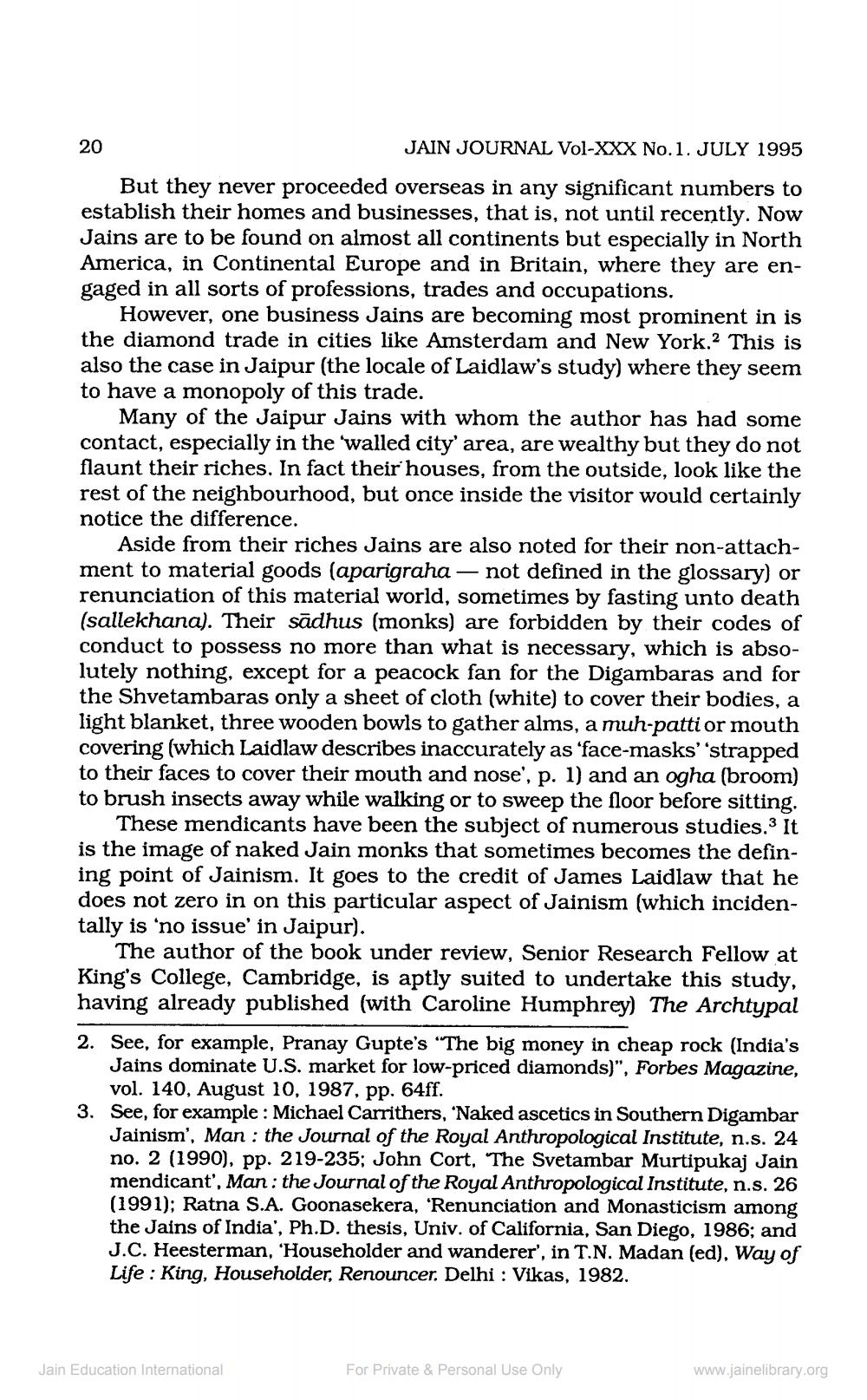Book Title: Jain Journal 1995 07 Author(s): Jain Bhawan Publication Publisher: Jain Bhawan Publication View full book textPage 4
________________ JAIN JOURNAL Vol-XXX No. 1. JULY 1995 But they never proceeded overseas in any significant numbers to establish their homes and businesses, that is, not until recently. Now Jains are to be found on almost all continents but especially in North America, in Continental Europe and in Britain, where they are engaged in all sorts of professions, trades and occupations. However, one business Jains are becoming most prominent in is the diamond trade in cities like Amsterdam and New York.2 This is also the case in Jaipur (the locale of Laidlaw's study) where they seem to have a monopoly of this trade. Many of the Jaipur Jains with whom the author has had some contact, especially in the 'walled city' area, are wealthy but they do not flaunt their riches. In fact their houses, from the outside, look like the rest of the neighbourhood, but once inside the visitor would certainly notice the difference. 20 Aside from their riches Jains are also noted for their non-attachment to material goods (aparigraha not defined in the glossary) or renunciation of this material world, sometimes by fasting unto death (sallekhana). Their sadhus (monks) are forbidden by their codes of conduct to possess no more than what is necessary, which is absolutely nothing, except for a peacock fan for the Digambaras and for the Shvetambaras only a sheet of cloth (white) to cover their bodies, a light blanket, three wooden bowls to gather alms, a muh-patti or mouth covering (which Laidlaw describes inaccurately as 'face-masks' 'strapped to their faces to cover their mouth and nose', p. 1) and an ogha (broom) to brush insects away while walking or to sweep the floor before sitting. These mendicants have been the subject of numerous studies.3 It is the image of naked Jain monks that sometimes becomes the defining point of Jainism. It goes to the credit of James Laidlaw that he does not zero in on this particular aspect of Jainism (which incidentally is 'no issue' in Jaipur). The author of the book under review, Senior Research Fellow at King's College, Cambridge, is aptly suited to undertake this study, having already published (with Caroline Humphrey) The Archtypal - 2. See, for example, Pranay Gupte's "The big money in cheap rock (India's Jains dominate U.S. market for low-priced diamonds)", Forbes Magazine, vol. 140, August 10, 1987, pp. 64ff. 3. See, for example: Michael Carrithers, 'Naked ascetics in Southern Digambar Jainism', Man: the Journal of the Royal Anthropological Institute, n.s. 24 no. 2 (1990), pp. 219-235; John Cort, The Svetambar Murtipukaj Jain mendicant', Man: the Journal of the Royal Anthropological Institute, n.s. 26 (1991); Ratna S.A. Goonasekera, 'Renunciation and Monasticism among the Jains of India', Ph.D. thesis, Univ. of California, San Diego, 1986; and J.C. Heesterman, 'Householder and wanderer', in T.N. Madan (ed), Way of Life: King, Householder, Renouncer. Delhi: Vikas, 1982. Jain Education International For Private & Personal Use Only www.jainelibrary.orgPage Navigation
1 2 3 4 5 6 7 8 9 10 11 12 13 14 15 16 17 18 19 20 21 22 23 24 25 26 27 28 29 30
